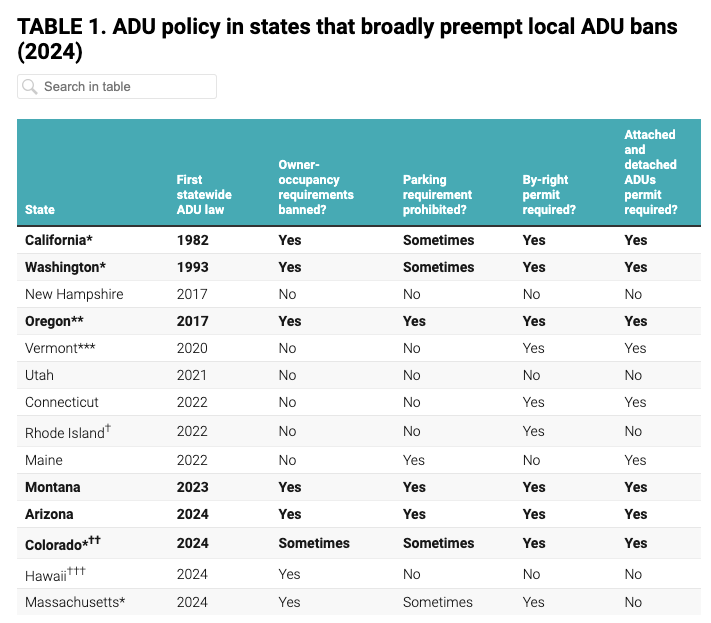

Hey readers, this is a pretty quick note to share some personal news: I’m thrilled to announce that I am a Visiting Fellow at the Center for Economy and Society at Johns Hopkins SNF Agora Institute for the 2024-25 academic year. CES is the perfect spot for me as it:
“aims to provide a pluralistic space in which scholars and practitioners with different approaches to the political economy of liberal democracy can productively work out their disagreements, discover common ground, and build new frameworks for governance.”
As part of the Center’s ongoing exploration of housing solutions across the political spectrum, I am working on a project to understand why Accessory Dwelling Units (ADUs) have become everyone’s favorite type of housing regardless of political party — and how we can leverage that support to create more attainable housing options.
Zoning reforms that override local bans on ADUs have spread to at least 14 states, ranging from blue states like California and Massachusetts to red states like Montana and swing states like Arizona and Colorado. A recent policy brief by Emily Hamilton and Abigail Houseal provides a useful taxonomy of what’s on the books already.
As more states are adopting ADU reform, they’re learning from past mistakes that prevented ADUs from actually getting built, such as requirements that ADUs be owner-occupied or have separate parking.
As ADUs are getting easier to build, permits to build them are skyrocketing. Jenny Schuetz and Eve Devens at the Brookings Institution just published a review of California’s decade of refining its ADU laws and the results are impressive. For example, In 2018, around 9,000 ADUs were permitted across the entire state. In 2023, Los Angeles County alone permitted more than 45,000 ADUs.
Think about other efforts to address housing construction, affordability and density, such as eliminating parking minimums, allowing multi-family housing by right, or upzoning near transit. These initiatives have not been broadly popular — in fact, they’re mostly contentious, political non-starters. So-called gentle density efforts, like duplexes or pocket neighborhoods, seem innocuous like ADUs but have had little traction. By contrast ADUs are increasingly welcome, and as we saw with the latest Massachusetts housing package, they are “table stakes” for statewide housing policy these days.
Of course, as ADUs have gotten popular, researchers, politicians and regular people have focused their debate and research on topics such as whether or not ADUs actually increase affordability, on whether regular people can afford to build them, on the challenges of financing them and so on. Schuetz and Devens also note that there are many layers of obstacles to housing production in California, and changing zoning is just part of the solution.
These are very important topics to research and it will be interesting to see what the data show in the coming years. But I’m interested in something else here: what we should do with the political spectrum that supports ADUs.
Libertarian-leaning people like ADU reform because it reinforces property rights and deregulates land use. ADUs don’t require public subsidy and their construction is a positive for the economy. Liberals like ADUs because they could enable more affordability or at least price diversity in neighborhoods. They play an important role in the care economy that Kamala Harris is promoting. Conservatives like them because they can enable large families to live together, and also help people monetize the extra space in their backyard. In these ultra polarized times, ADUs are at the center of the politics Venn diagram.
My question then is: What else is possibly at the center? And how do you build upon the success of ADUs? Over the course of the year, I hope to propose some answers to these questions. It’s a tantalizing prospect to think that more expansive zoning reform is in reach if we can build upon the inroads made by ADU reform.
Some of the questions I’m exploring include:
What are other housing types that could mimic the benefits of ADUs and also find a political majority? I’ve started looking at single stair buildings, but what about other missing middle housing types?
Who are the strange bedfellows that are forming coalitions that have made ADUs successful? What other housing innovations might these groups support?
If the underlying issue of ADUs is reforming building code, could a broader building code reform movement become the next YIMBY movement?
I’m sure many other questions will form as I start researching these topics. I’m excited to share some learnings with you over the coming months.
Please feel free to reach out by responding to this email, sending me a DM on the Substack app, or writing a comment below if you have suggestions of people to interview, stories to write, innovations to include, or projects to visit.
I’ll be back later in the week with a new post!
Also: If you regularly enjoy this column and like to support people to do the work they love, please consider upgrading to a paid subscription.
You May Also Like:













And glad you are thinking about the building code and not just the planning code.
We built 2 ADUs in Oakland and the planning process was a breeze, but a lot of nonsense in the building code (and around it) added a lot of cost to construction (and therefore higher rent for tenants).
Excited for your new role, Diana